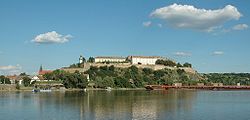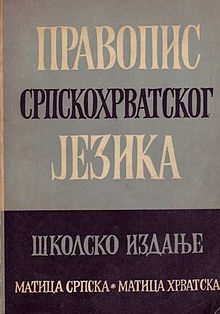- Novi Sad Agreement
-
The Novi Sad Agreement was an attempt by twenty five Serbian, Croatian and Montenegrin writers, linguists and intellectuals to build unity across the ethnic and linguistic divisions within Yugoslavia, and created the Serbo-Croatian language.
Sponsored by the Serbian cultural organization's journal Letopis Matice srpske editorial board, talks on the use and acceptability of the Serbian, which uses the Cyrillic alphabet and is centered around the city of Belgrade (known as the eastern variety of Serbo-Croat) and Croatian (which uses the Roman alphabet, centered around the city of Zagreb, and is known as the western variety of Serbo-Croat) took place in the city of Novi Sad, in the Serbian province of Vojvodina. Two days of discussion from December 8th through December 10th, 1954, resulted in the signing of the agreement, which laid out ten resolutions regarding the languages and their relations to one another.
The agreement focused on the similarities between the two dialects, and was primarily concerned with reconciling the different dialects for the benefit of a federalized Yugoslavia. The agreement stated that groups of linguists and intellectuals who from both the eastern Serbian variant and the western Croat variant, would work together toward establishing a single dictionary and terminology.
The agreement ironically also stated that the future language should develop naturally, although it was being forged by the force of political will and pressure from both dialects.
The new terminology and dictionary would have its roots in both languages, and the literary journal present at the agreement would have the same content published in both Cyrillic Serbian and Roman Croatian.
However, many, such as Croatian intellectual Ljudevit Jonke, viewed the agreement as a veiled attempt to have Serbian become the official language of a Federal Yugoslavia, and to wipe out other languages such as Dalmatian, with only a passing nod given to Croat.
As a direct result of the agreement, Matica srpska and its Croatian counterpart Matica hrvatska published an orthography manual in 1960. Although widely praised by all levels of Serbian and Yugoslav party officials and intellectuals, the orthography was roundly criticized by Croatian intellectuals, who saw the work as too Serb-centric. Their criticisms stemmed mainly from an analysis of the case of larger differences between the two languages, claiming that the dictionary favored the eastern variant of the language over the Croatian.
Contents
The text of the Novi Sad Agreement
The ten "Conclusions", or zaključci
- Serbs, Croats and Montenegrins share a single language with two equal variants that have developed around Zagreb (western) and Belgrade (eastern).
- Officially, the name of the language must make reference to its two constituent parts (i.e. both "Serbian" and "Croatian")
- The Roman and Cyrillic alphabets have equal status and Serbs and Croats are expected to learn both alphabets in school.
- The two pronunciations—ijekavian and ekavian—have equal status in all respects.
- The Matica srpska will cooperate with the Matica hrvatska in the production of a new dictionary of the joint language.
- Work will proceed on the establishment of a common terminology for all spheres of economic, scholarly, and cultural life.
- Both sides will cooperate in the compiling of a joint orthographic manual (pravopis).
- Care must be given to the natural development of Croato-Serbian, and no longer should texts be altered from one variant to another.
- The composition of a Commission from the pravopis and terminology will be decided by universities in Zagreb, Belgrade, and Sarajevo, the Academies in Zagreb and Belgrade, Matica hrvatska, and Matica srpska.
- The conclusions will be made available by Matica srpska to the Federal Executive council (i.e., the federal Yugoslav government), the governments of Serbia, Croatia, Bosnia-Herzegovina and Montenegro, and to the universities, the Matica hrvatska in Zagreb, and to daily papers and journals.[1]
The Implications of the Agreement
The agreement is also seen as a high point in relations between the Serbian and Croatian factions within the federal Yugoslavia, which quickly devolved. Soon after the death of Stalin, the nation was no longer able to define itself as a distinct and opposite kind of communist nation, and so building a federal, unified Yugoslavia was no longer the top priority for the nation. Factional disagreements and power struggles following a scandal in which the head of the Yugoslav security services, the UDBA, had bugged the residences of top Serbian party officials, and had even placed Yugoslav leader Josip Broz Tito himself under surveillance.
The bugging plan was masterminded by Aleksandar Ranković and overseen by a Croat general, namely Ivan Gošnjak. Ranković was fired by Tito and stripped of all of his posts. However, he was never incarcerated for his involvement.
The ensuing scandal was seen as a de facto victory for the rest of the various factions within Yugoslavia, and the clamor for more separation from the federal state grew larger. In 1967, the Croats responded to this outcry by refusing to honor the agreement, which was representative of the fractious nature endemic to not only the nation but the region as a whole.
Notes
- ^ Greenberg (2004, p. 31)
References
- Greenberg, Robert David (2004), Language and identity in the Balkans, Oxford University Press, pp. 29–32, ISBN 0199258155, http://books.google.com/?id=3ZvDJQHaUZkC&pg=PA29
- Bellamy, Alex J. (2003), The formation of Croatian national identity, Manchester University Press, pp. 138–140, ISBN 071906502X, http://books.google.com/?id=T3PqrrnrE5EC&pg=PA138
- Woodow Wilson Center for International Scholars, East Europe Studies, Report No. 182, By Robert Greenberg
- The languages of the former Yugoslavia--The Disintegration of Serbo-Croatian
- Eastern Europe in the Twentieth Century - And After, By. R. J. Crampton
Categories:- 1954 in Yugoslavia
- Serbo-Croatian language
- Croatian language
- Serbian language
Wikimedia Foundation. 2010.



